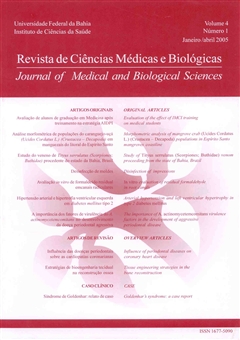Morphometric analysis of mangrove crab (Ucides Cordatus L.) (Crustacea - Decapoda) populations in Espírito Santo mangroves coastline
DOI:
https://doi.org/10.9771/22365222cmbio.v4i1.4153Keywords:
U. cordatus - genetic divergence, animal conservation, MANOVA.Abstract
The mangrove crab (Ucides cordatus) is a crustacean (Decapoda: Brachyura) of great cultural, biological and commercial value in all Espírito Santo. However, there is still a great lack of data regarding the mangrove crab. In order to minimize this situation, the present work carried through a study on the population divergence of Ucides cordatus in Espírito Santo mangroves. Four morphometric features have been analysed in 172 male individuals, from São Mateus (N=62), from Vitória (N=60) and from Anchieta (N=50). Meaningful difference between the three populations was observed (p < 0,01) by the Multivaried Analysis. The greatest degree of similarity was found between São Mateus (North) and Anchieta (South) so they had been classified in a single group. Vitória (Center) was enclosed in another group, evidencing divergence between this population and the other. This results suggests differents pressure by selection in the interior populations in relation with de capital populations, which may be connected with a greater human action on the capital populations.Downloads
Download data is not yet available.
Downloads
Published
2005-08-18
How to Cite
Miranda, C. L., Barbosa, R. P., Lima, A. de S., Rovida, J. C., Rocha, J. C., Souza, L. S. de, Pires, A. V., Martins, R. L., & Paiva, S. R. (2005). Morphometric analysis of mangrove crab (Ucides Cordatus L.) (Crustacea - Decapoda) populations in Espírito Santo mangroves coastline. Journal of Medical and Biological Sciences, 4(1), 15–23. https://doi.org/10.9771/22365222cmbio.v4i1.4153
Issue
Section
ORIGINAL ARTICLES
License
The Journal of Medical and Biological Sciences reserves all copyrights of published works, including translations, allowing, however, their subsequent reproduction as transcription, with proper citation of source, through the Creative Commons license. The periodical has free and free access.


